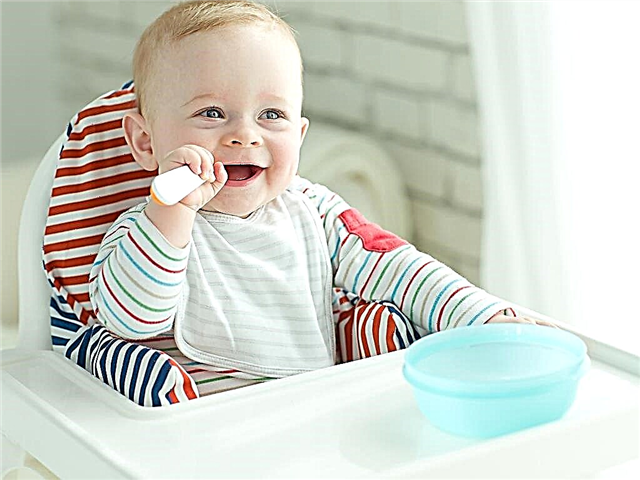
On the healthy skin of the child, there should be no foreign spots. Their appearance usually indicates that some pathological disorders occur in the child's body. This article will help you figure out in what situations and diseases spots appear on the skin.

Causes
The physiological color of the skin is pale pink. In a newborn baby, the skin is quite delicate, through which the blood vessels are clearly visible. The skin of babies is sufficiently moisturized.
The appearance of various rashes on the skin most often indicates the occurrence of a pathological process.

The following reasons can lead to the appearance of spots on the baby's skin:
- Disruption of the endocrine system. A wide variety of hormones are required for the full growth and development of a child. A malfunction of the endocrine system contributes to the appearance of various red spots on the skin. They may feel rough to the touch. The size of such formations usually reaches several centimeters.
- Herpes infection... It is manifested by the appearance of red spots with bubbles on the child's skin. Serous-bloody fluid is contained inside these elements. A herpetic rash can occur on almost any part of the body, but most often it affects the mucous membranes of the lips and genitals.
- Children's infections. Measles, rubella, chicken pox are quite common causes of various skin rashes on the skin of babies. Each of the pathologies has its own specific characteristics of the rash.
These childhood infections are manifested by the appearance on the skin of numerous red spots, which can be located on almost all parts of the body.

- Allergic pathologies. The appearance of red, rough spots on the skin is often a skin manifestation of allergies. These elements appear when various provoking factors - allergens - enter or act on the body. These symptoms occur in babies who have individual hypersensitivity to specific chemicals or foods.
- Atopic dermatitis... Causes the appearance of bright red spots on the baby's skin, which can cause severe itching in the baby. This pathology has a pronounced hereditary character. In the presence of a burdened family history, the risk of atopic dermatitis in a child increases several times.

- Contact dermatitis. Every mother raising a baby can meet with this pathology. Most often, contact dermatitis occurs in babies under one year old. It occurs as a result of an allergic reaction caused by a chemical. In children, the development of contact dermatitis is caused by the use of incorrectly selected diapers or wearing clothes made from synthetic materials.
- Skin pigmentation disorders. This condition occurs quite often in children's practice. It is characterized by the appearance of white patches on tanned skin. This pathological condition is associated with a violation of the content of melanin in the skin layers - the main pigment that provides normal color. The appearance of white spots on the skin after sunburn should alert parents and motivate them to seek advice from a pediatrician.
- Eczema. It is manifested by the appearance of weeping pink spots on the skin, which can be located on different parts of the body. Most often, eczema forms in those anatomical areas that are most often exposed to provoking external factors. These are, as a rule, palms and feet. The size of the spots on the skin with eczema can be different.
- Seborrheic dermatitis. It can occur in various pathological conditions. It is characterized by the appearance of yellow spots on the scalp. Another specific symptom of the disease is a huge amount of easily peeled skin scales (dandruff). The peak incidence occurs during adolescence.


- Chronic diseases of internal organs. Liver pathologies are often manifested by the appearance of yellowish spots on the skin. With the development of jaundice in a child, all the skin acquires a uniform yellow color. The appearance of coffee and brown spots on the skin may indicate problems with the functioning of the kidneys. Dark and bronze rashes can be the result of serious adrenal disease.
- Parasitic invasions. In the course of their life, helminths secrete a lot of different substances that have their toxic effect on the child's body. Quite often, with helminthic diseases, various spots appear on the skin of babies. They can be of different colors and sizes. As a rule, these skin rashes are very itchy.

- Impact of adverse environmental factors. Severe hypothermia or contact with low-quality baby cosmetics often leads to the fact that the baby's skin becomes dry. In some cases, various skin spots and rashes appear on it. Most often they look like light or red formations.
- Ichthyosis... This is a genetic pathology that is quite difficult in babies. The first adverse symptoms appear in a child already in early childhood. The disease is characterized by the appearance of grayish and white spots on the skin. These skin elements are numerous and resemble "fish scales" in appearance.

- Endemic diseases. In our country, infections that occur in babies as a result of ixodid tick bites are widespread. These insects are carriers of dangerous diseases - viral tick-borne encephalitis and borreliosis. The appearance of a spot on the body with a bright red rim may indicate that the child has the first signs of Lyme disease.
- Prickly heat. This pathology is one of the most common in babies in the first year of life. This pathological condition develops when the process of thermoregulation is disturbed, as a result of which the secretion of secretion by the sweat glands is disturbed. This pathology is characterized by the appearance on the child's skin of various red spots, which are quite large in area.

- Deprive Gibert. It occurs after a viral or bacterial infection suffered by a child. It is manifested by the appearance of bright pink spots on the skin. The size of the skin elements is usually from 2 to 4 cm. The spots disappear from the skin on their own, without prescribing treatment.
- Fungal diseases. Causes white spots on the skin. They arise as a result of the toxic effects on the skin of biologically active waste products of fungi. Fungal spots are usually round or oval. In some cases, they merge with each other, forming rather large areas of the affected skin.


How do they manifest?
The appearance of various rashes on the baby's skin is a reason to see a doctor. Differential diagnosis at home is difficult. Skin diseases are dealt with pediatric dermatologists. These specialists conduct a full clinical examination and examination of the baby, as a result of which they will be able to establish the correct diagnosis.


The severity of symptoms in different diseases can be different. The intensity of the color of skin rashes is also significantly different. In the midst of the acute period of the disease, spots on the skin have a more intense color, then gradually fade. After cleansing from skin rashes, areas of depigmentation remain on the skin, as a rule. They look like white or light spots that disappear completely after a few weeks.
Localization of skin rashes can be different. With contact allergic pathologies, spots appear in places of direct contact.

Infectious diseases are characterized by the appearance of skin rashes on almost all parts of the body: from the face to the heels:
- The appearance of white patches of skin on the skin may be triggered by vitiligo disease. This disease is characterized by the formation of fairly large white spots on the skin, while there are no other adverse symptoms. Usually specks of irregular shape, have bizarre outlines. Doctors consider this condition to be more cosmetological than pathological. Most often, the first symptoms occur during adolescence.
- Combination of cutaneous elements and systemic disorders is very unfavorable and always indicates the presence of persistent pathology in the body. One of these diseases is tumorous sclerosis. This condition is congenital. It is characterized by a lag in the baby's physical and mental development, the appearance of epileptic seizures, as well as the appearance of large spots on the skin that cover the skin on the hands and feet.


- Pale large spots can occur in babies and with various pathologies of the immune system. Congenital or acquired immunodeficiencies are manifested by the appearance of fairly light areas on the skin. The highest risk group includes premature babies, as well as babies born during complicated pregnancy. Congenital abnormalities that lead to permanent metabolic disorders also contribute to the appearance of white patches on the child's skin.

- Psoriasis - This is a fairly common dermatological pathology, which is accompanied by the appearance of various spots on the skin. It is a family disorder that is inherited. As a rule, the first manifestations of the disease occur during adolescence. This pathology is characterized by the occurrence of itchy spots, which can be located on the back, face, upper half of the body, on the knees and elbows. Psoriatic skin elements are usually red in color, rather rough to the touch.
Skin rashes can be of a wide variety of shapes and shapes. Such a variety of clinical options makes it difficult for doctors to establish the correct diagnosis. Quite often, in order to determine exactly the cause of the appearance of spots on the skin, a large complex of various diagnostic methods is carried out.
In difficult clinical situations, a medical consultation is required, which is attended by specialists from different medical specialties.

The duration of the preservation of the rash on the skin can be different and depends on the cause of the disease, which caused them to appear on the skin. Red spots that occur as a result of various childhood infections usually completely disappear from the skin within 7-14 days from the moment the first rashes appear. Fungal variants take a little longer. Skin manifestations with contact dermatitis completely disappear after a few days, provided that allergens do not enter the child's body during this period.

Recommendations
When pathological rashes appear on the skin, the appointment of complex therapy is required. The treatment regimen is determined by a pediatric dermatologist after conducting diagnostic examinations. The duration of therapy depends on the cause that caused the disease.

To remove various spots from the skin, you should use the following recommendations:
- Limit any contact with allergens... Compliance with a hypoallergenic diet with the exception of highly allergenic foods is indicated for all allergic babies, without exception. Choose baby clothes made only from quality materials. Try to limit your child's wearing synthetic materials.
- Choose baby cosmetics, which does not contain aggressive chemical fragrances and dyes. Pay attention to the markings that are always present on the packaging with this product.
For children who have a tendency to develop allergic reactions, it is advisable to choose cosmetic products that have a hypoallergenic composition.


- Wet mop more often children's room. Quite often, exposure to household dust leads to the appearance of various allergic red spots on the skin of babies. Perform general cleaning of the premises regularly using disinfectants. They will help reduce the concentration of microorganisms in the nursery.
- Don't bathe your baby often. To maintain optimal skin moisture, it is very important to protect its water-lipid layer. Hot or prolonged baths can cause the skin to dry out a lot and various specks appear on them. Carrying out daily hygiene procedures is sufficient to maintain and maintain cleanliness and health of the skin.


- Use decoctions of medicinal herbs when irritation appears on the baby's skin. For this, infusions made from a string, pharmacy chamomile or calendula are excellent. You can add them to the bath when bathing. These affordable tools, always available in every home medicine cabinet, will be an excellent prevention of many dermatological diseases in children.
- Choose warm and comfortable clothes for walking. Do not over-wrap your child. This will only contribute to the fact that all thermoregulation processes are significantly disturbed in the baby. Try to give preference to light, but at the same time warm clothes that will protect the baby from wind and frost.

- Use for washing baby clothes and clothes special household chemicalsthat are approved for use in children. Many mothers, using the advice of older friends, wash with baby soap. This use is perfectly acceptable. Try to limit the use of any household chemicals that have a pungent smell or too saturated color.
- With increased dryness of the skin use moisturizers and body lotions. Regular use of such products will have a beneficial effect on the skin. It will become more tender and hydrated. It is better to apply moisturizing baby cosmetics after bathing the baby. After applying the cream, leave the product on the skin until it dries naturally.

- For babies use diapers that do not cause any redness on the baby's skin and rashes. The selection should be carried out only taking into account the individual sensitivity of the baby. If, after removing the diaper, areas of redness or small red rashes appear on the skin, then this is a characteristic symptom of an allergic reaction of the child. In this case, the brand of the diaper should be replaced.
- To eliminate adverse skin symptoms use various medicines... It is important to note that before using any drug, you should definitely consult with your doctor. To eliminate spots on the skin caused by various reasons, the following are often used: "D-panthenol", "Fenistil-gel", "Bepanten" and others.
- Regularly get tested with your child from doctors if he has chronic diseases of internal organs. The long course of some somatic pathologies leads to the appearance of various spots on the skin of the crumbs.
Babies with chronic diseases must be monitored by specialists in the relevant specialties.

In the next video, Dr. Komarovsky will talk about the main causes of rashes and spots in children.



